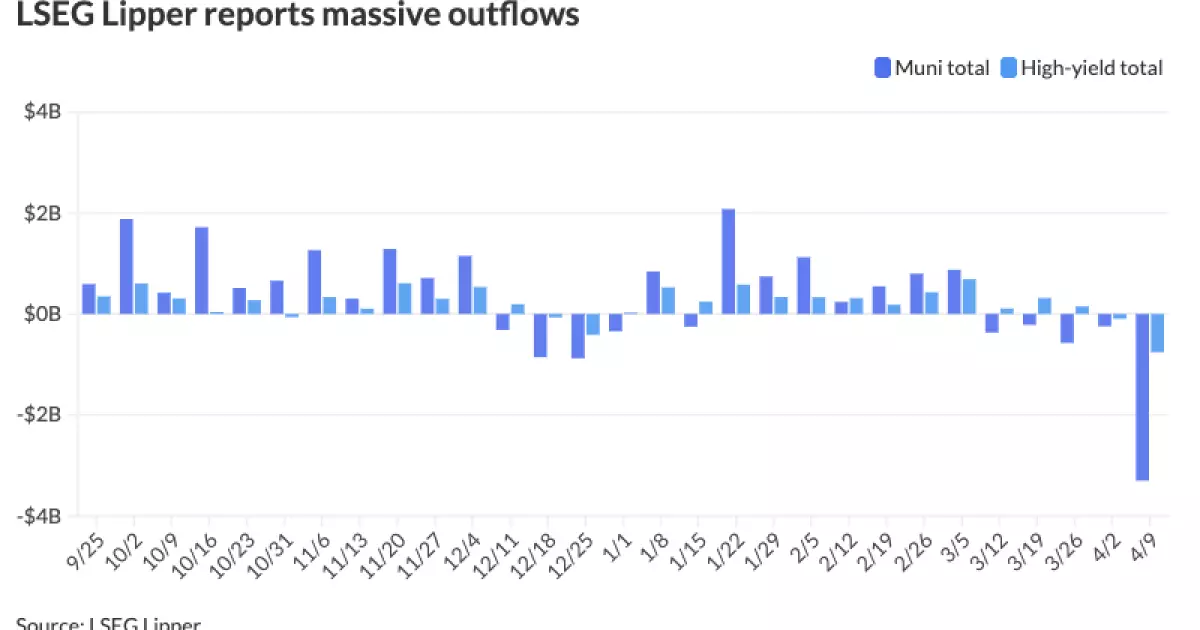The municipal bond market has taken a sharp twist this week, bearing witness to a staggering $3.3 billion outflow from municipal bond mutual funds, marking the largest exit since June 2022. It’s not just a fleeting tremor; this is an earthquake that could redefine how investors approach this asset class moving forward. Under normal circumstances, such selling pressure would send the financial community into a frenzy, yet amid the tempest, some analysts predict an upswing is on the horizon. What are we witnessing—a market correction or an investor exodus? Perhaps it’s both, drenched in a potent cocktail of uncertainty and hope.
Municipal bonds have traditionally been the safe havens for conservative investors, representing a relatively stable option with tax advantages. However, the recent flurry of volatility has left even the most steadfast investors feeling anxious. An important economic indicator released this week indicated a slower rise in inflation than anticipated. While a 2.4% inflation rate year-over-year is indeed a positive sign, juxtaposed against bond prices in freefall, this is the kind of ambiguity that keeps investors awake at night. The specter of rising Treasury yields looms large and has cast a shadow over municipal bonds, pushing yields higher even in the face of supposedly favorable economic data.
Rising Yields amid Market Chaos
As prices recovered, a concerted 90-day tariff pause should have calmed the market, but it seems to only add more fuel to the fire of uncertainty. Traders tend to react based on sentiment rather than the hard numbers; the mixed signals make for an unsettling environment, causing even experienced investors to rethink their strategies. Municipal AAA scales experienced substantial yield volatility, depreciating by as much as 54 basis points, a stark reminder of how fragile stability is in the current climate.
Michael Pietronico, CEO of Miller Tabak Asset Management, characterized Wednesday as a “washout day,” vividly illustrating the extreme swings that have defined this week. Such sentiment amplifies my belief that bond markets, once considered bastions of safety, are now grappling with self-inflicted wounds and external pressures that are fracturing investor confidence. Despite this bearish atmosphere, the clang of optimism remains: “You’re not going to see those yields for the rest of the year,” Pietronico noted. This dichotomy underscores the tension between immediate chaos and what some perceive as a stabilizing future.
The Plight of the Municipal Bond Investor
What does this mean for the municipal bond investor? In a market where $3 billion in outflows is a grim indicator of eroding confidence, it’s critical to scrutinize the factors contributing to this dramatic shift. The combination of historically high supply with vague tax policies emerging out of Washington has set the stage for a turbulent landscape. Tom Murphy, a senior analyst at Morningstar, highlighted a noticeable tapering trend in inflows, reinforcing the need for strategic insight into this evolving scenario.
Investors have been skittish, as long-term bonds faced hefty outflows. With the prospect of continuing volatility looming overhead, it’s essential for municipal bond investors to re-evaluate risk tolerance and investment horizons. Many may argue that the tax-exempt nature of municipal bonds remains attractive, but when price stability is compromised, the fundamental appeal can swiftly diminish, leading to panic selling, much like the recent withdrawals from both municipal mutual funds and ETFs.
An Industry at a Crossroads
The ramifications stretch beyond just immediate financial losses; they strike at the heart of how municipal bonds will be perceived moving forward. The pricing adjustments may very well be just the beginning, as dealing houses perceive a cautious optimism that hasn’t historically been the case in uncertain times. “People now feel like their footing is a little bit more stable,” said Mark Paris at Invesco, hinting at a search for equilibrium amid the tumult.
Yet, should we really believe that this is a sign of resilience, or are we merely witnessing a false dawn? With Treasury markets showing losses and the potential for more volatility on the horizon, a troubling question persists—does this impossible balancing act of optimism and skepticism signal a paradigm shift in the municipal bond arena?
With tariffs and varying inflation rates dictating much of the conversation, one cannot discount how political developments entwine with economic indicators. The decisions looming out of the White House hold significant sway over municipal bond performance. It raises an important thought: are we watching a mere blip in a long-term trajectory, or are these the harbingers of a seismic shift that will redefine the future of municipal bonds? How investors and policymakers navigate these waters remains to be seen, but the indecision is palpable.


Leave a Reply